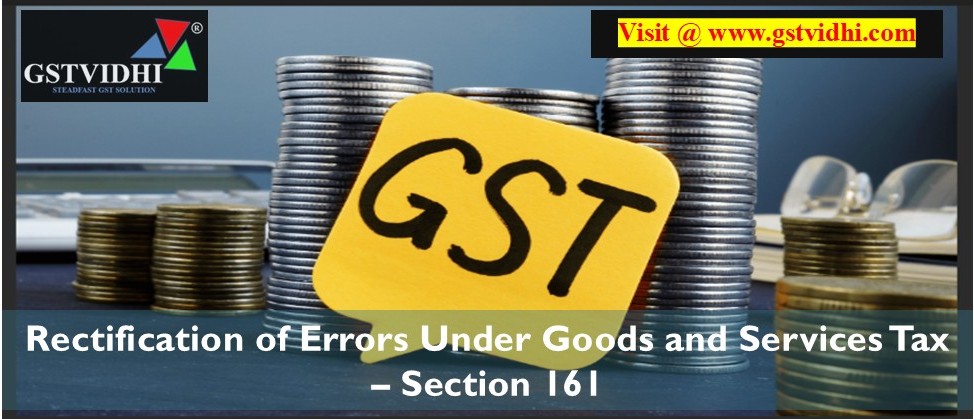
Section 161 of GST Act– Rectification of Errors Apparent on the
Face of the Record Under Goods and Services Tax
Introduction:
Under
the GST law, authorities pass a variety of decisions, orders, notices, and
certificates. Sometimes, these documents may contain clear and obvious mistakes
— such as typographical errors, miscalculations, or clerical omissions. To
address such issues without going through the lengthy appeal or revision route,
Section 161 of the Central Goods and Services Tax (CGST) Act, 2017
provides a summary remedy for rectification of errors apparent on the
face of the record.
This provision enables a
swift correction mechanism that safeguards taxpayers from being penalized or
burdened due to minor and unintentional errors.
Statutory
Provision – Section 161 CGST Act
"Without prejudice
to the provisions of section 160, and notwithstanding anything contained in any
other provisions of this Act, any authority who has passed or issued any
decision or order or notice or certificate or any other document may rectify
any error apparent on the face of the record, either on its own motion or on
being brought to its notice by:
- any officer under CGST/SGST/UTGST, or
- the affected person, within 3
months from the date of issuance of such document."
Time
Limits:
- Rectification can be done within 6
months from the date of issuance of such
document.
- This 6-month time limit does not
apply for clerical or arithmetical errors due
to accidental slip or omission.
- If the rectification adversely
affects a person, the principles of natural justice must be
followed.
Key
Features of Section 161
|
Particulars
|
Explanation
|
|
Scope
|
Applies
to any decision, order, notice, certificate, or document under GST
|
|
Who
can rectify?
|
The
same authority that issued the document
|
|
Mode
of rectification
|
Suo
moto (on its own) or upon request
|
|
Who
can bring error to notice?
|
GST
Officer (CGST/SGST/UTGST) or affected person
|
|
Time
Limit for request
|
Within
3 months from the date of issuance
|
|
Time
Limit for rectification
|
Within
6 months (except clerical/arithmetical error)
|
|
Natural
Justice
|
Must
be followed if adverse impact on taxpayer
|
What Is an
“Error Apparent on the Face of Record”?
The phrase "error
apparent on the face of the record" has been subject to judicial
interpretation. Typically, it includes:
- Typographical errors
- Mathematical miscalculations
- Incorrect date or PAN/GSTIN entered
- Omission of facts already on record
- Wrong reference to a section or rule
- Unintentional slip or oversight
But it does not
include:
- Errors requiring detailed
reasoning, debate, or legal interpretation
- Change in opinion or interpretation
after review
Example:
If a tax officer
calculates interest wrongly due to an incorrect number of days, this is a
rectifiable arithmetical mistake under Section 161.
Procedure
to File a Rectification Request under Section 161
If a taxpayer notices an
error in a decision, order, or notice, they may follow this step-by-step
process:
Step-by-Step
Guide:
1. Identify
the Error
o Confirm
that it is apparent on the face of the record, e.g., wrong amount,
incorrect name, misquoted date, etc.
2. Draft
a Rectification Application
o Include
the following:
§ GSTIN
and legal name of the applicant
§ Date
and reference of the original order/notice/document
§ Description
of the error with supporting evidence
§ Request
for correction under Section 161
3. Timeline
Compliance
o File
the request within 3 months from the date of the original document.
4. Submit
the Application
o File
electronically (User Services – My Application – Rectification of Order)
5. Acknowledgement
o Keep
acknowledgment/receipt of submission for future reference.
6. Decision
by Authority
o If
the authority agrees that the error is apparent, they may rectify it within
6 months.
o In
case of adverse effect, opportunity of hearing must be given.
7. Rectified
Order Issued
o A
new order or corrigendum is issued rectifying the mistake.
Sample
Format for Rectification Request
To,
The Proper Officer,
Office of [Jurisdiction],
GST Department.
Subject: Application for
Rectification of Error under Section 161 of CGST Act
Respected Sir/Madam,
This is to bring to your
kind notice that an error apparent on the face of the record has occurred in
the [Order/Notice/Document] bearing reference number ________ dated ________,
issued under Section _____ of CGST Act.
Details of Error:
[Clearly explain the
error – e.g., wrong calculation of tax, clerical error, incorrect date, etc.]
Supporting Documents:
[List of enclosures, if
any]
Therefore, we request
your good office to kindly rectify the above-mentioned error under the
provisions of Section 161 of the CGST Act, 2017.
Thanking you,
Yours faithfully,
[Name]
[Designation]
[GSTIN]
[Contact Details]
Conclusion:
Section 161 of the CGST
Act provides a taxpayer-friendly tool for correcting obvious and
unintentional mistakes in GST orders and notices. It strikes a balance
between procedural ease and administrative discipline. However, taxpayers must
act within prescribed time limits and ensure the error is clearly
identifiable.
In summary, not all
errors qualify, but when used judiciously, Section 161 helps avoid
unnecessary litigation and ensures fair and efficient tax administration.
Disclaimer: All the Information is based on the notification, circular advisory and order issued by the Govt. authority and judgement delivered by the court or the authority information is strictly for educational purposes and on the basis of our best understanding of laws & not binding on anyone.
Click here